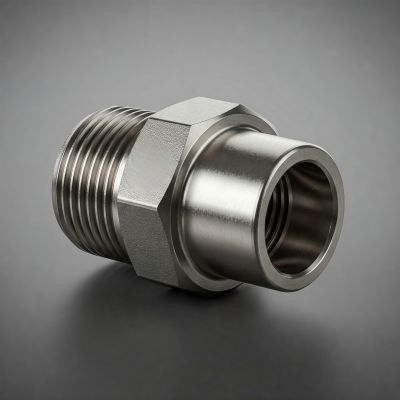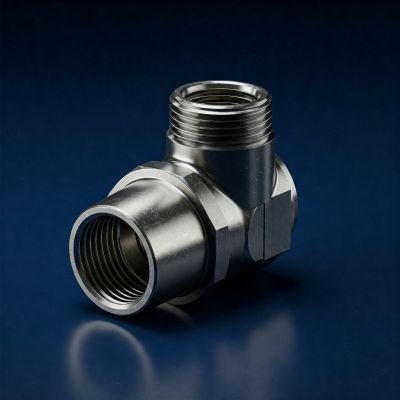Flare fittings play a crucial role in fluid and gas systems, ensuring secure, leak-proof connections in high-pressure applications. However, there is often confusion between 37° flare and 45° flare fittings, leading to issues with compatibility and performance.
This guide aims to clarify the key differences between these two flare fitting types, their applications, and how to select the right one for your needs.
What Are Flare Fittings?
Flare fittings are mechanical connectors used to create reliable, leak-proof seals in piping and tubing systems. They achieve this by flaring the end of a tube to fit precisely against a mating fitting. The flare angle ensures a secure metal-to-metal seal, preventing leaks even under high pressure.
Flared tubing is commonly used in industries such as hydraulics, fuel delivery, refrigeration, and plumbing. The benefits of flare fittings include:
➡️ High-pressure resistance
➡️ Reusability and easy disassembly
➡️ Strong and durable connections
Understanding 37° Flare Fittings
37-degree flare fittings utilize a 37-degree flare angle. Typically used with AN (Army-Navy) and JIC (Joint Industry Council) fittings.
Common Applications:
➡️ Found in aerospace, automotive, industrial hydraulics, and fuel systems.
Sealing Mechanism:
➡️ Seals via metal-to-metal contact, creating a secure high-pressure connection.
Standards & Specifications:
➡️ Governed by SAE J514 and MIL-F-5509.
Understanding 45° Flare Fittings
45-degree flare fittings utilize a 45-degree flare angle. They are commonly used in HVAC, refrigeration, and plumbing applications.
Common Applications:
➡️ Found in air conditioning, gas lines, and soft copper tubing connections.
Sealing Mechanism:
➡️ Seals via metal-to-metal flare contact, ensuring leak-proof joints.
Standards & Specifications:
➡️Governed by SAE J512 and ASME standards.
Key Differences Between 37° and 45° Flare Fittings
|
Feature |
37° Flare |
45° Flare |
|
Flare Angle |
37° |
45° |
|
Thread Type |
AN/JIC (SAE J514) |
SAE (J512) |
|
Common Applications |
Aerospace, automotive, hydraulics |
HVAC, refrigeration, plumbing |
|
Material Compatibility |
Stainless steel, aluminum, brass |
Copper, brass, soft metals |
|
Pressure Rating |
High-pressure |
Medium-pressure |
|
Sealing Method |
Metal-to-metal contact |
Metal-to-metal contact |
|
Interchangeability |
Not interchangeable with 45° |
Not interchangeable with 37° |
Can You Mix 37° and 45° Flare Fittings?
One of the most common questions is whether 37° and 45° flare fittings can be used interchangeably. The answer is no. The differences in flare angles result in poor alignment and improper sealing, which can cause leaks, pressure loss, and connection failures.
Risks of Improper Fitting:
➡️ Leaks due to improper mating surfaces.
➡️ Connection failure from mismatched angles.
➡️ Reduced system efficiency and increased maintenance issues.
If necessary, adapters can be used to convert between 37° and 45° flare fittings, but it is always best to use the correct flare type for your system.
How to Choose the Right Flare Fitting
When selecting a flare fitting, consider the following:
➡️ Pressure Requirements: Use 37° flare fittings for high-pressure systems like hydraulics and aerospace applications.
➡️ Fluid Type: Ensure material compatibility with the fluid being transported.
➡️ Industry Standards: Follow relevant specifications like SAE J514 for 37° flares and SAE J512 for 45° flares.
➡️ Material Selection: Choose the right material for your system, such as brass for plumbing, stainless steel for high-pressure systems, or aluminum for lightweight applications.
➡️ Check Compatibility: Always measure and confirm flare angles before installation to prevent mismatches.
Conclusion
Understanding the differences between 37° flare and 45° flare fittings is crucial for ensuring a safe, efficient, and leak-free connection. While both serve similar purposes, they are not interchangeable due to their distinct flare angles and applications.
To avoid costly mistakes, always use proper measuring tools, select the correct fitting type, and follow industry standards. By doing so, you can ensure optimal system performance and long-term reliability.
Post time: Feb-17-2025



